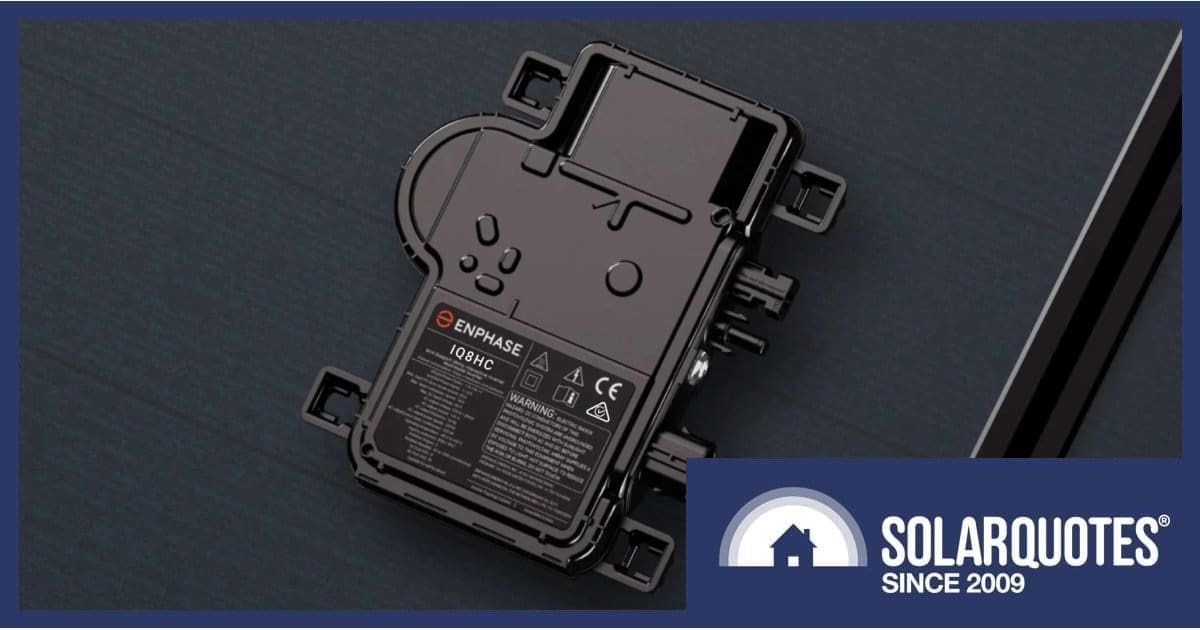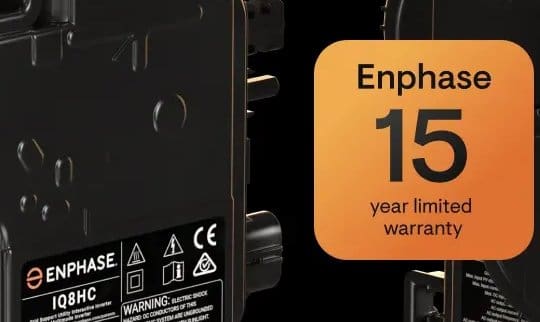
Enphase must be very confident in its IQ8 microinverters lasting the distance – the company says it has extended its standard limited warranty in Australia for new installations.
Inverters work day-in and day-out under often harsh conditions, particularly in Australia – and they are the component of a solar power system most likely to fail first. While many solar panels are accompanied by 25-year product warranties these days, inverters lag behind with 10-year warranties common; although some can be extended for an additional fee.
Enphase Energy is the world-leader in microinverters, which are basically a miniaturised version of a string inverter. Microinverters are usually mounted on the racking beneath solar panels; one per panel – although some offer multiple panel support. While protected from direct sunlight, the devices are exposed to high ambient temperatures, and heat and electronics don’t make great bedfellows.
But in a vote of confidence in the robustness of its tech, Enphase announced on Tuesday it was extending the standard warranty in Australia for its IQ8 microinverter product range from 15 years1 to 25 years. The new warranty terms automatically apply for all IQ8 Microinverters activated on or after 1 October 2024 according to the company.
“We identified the performance between solar panel and inverter warranties as a quality assurance issue that can compromise ROI for homeowners,” said Enphase Energy Australia General Manager Patrick Matweew. “Enphase is closing that gap to give households that chose Enphase unprecedented solar investment security.”
I went looking for the new extended warranty on Enphase’s Australian website yesterday and again this morning, but was unable to find it – and various mentions of warranty on the site still indicated 15 years.
The new warranty is a document you want to lay eyes on and examine closely before taking the plunge.
UPDATE 9AM: Here’s the new IQ8 warranty document, indicating 25 years.
Australia’s Long Wait For The IQ8
It was back in October 2021 when Enphase announced its IQ8 microinverters were to begin shipping in December that year for customers in North America.
There was plenty of interest in Australia in the devices, particularly given Enphase promoting the IQ8’s ability to form a microgrid during a blackout. This would prevent exports while providing backup power even without a battery – although this was going to require some extra (pricey) kit. However, the “Sunlight Backup” feature proved problematic. It was never released in Australia and has been withdrawn in the USA.
The IQ8’s were originally going to be available in Australia in the second half of 2022, but it wasn’t until June 2023 when the firm started accepting Australian orders.
Why Use Microinverters?
It used to be that microinverters had an edge over string inverters in partially shaded solar installations, but string inverter manufacturers have lifted their game in recent years with improved Maximum Power Point Tracking (MPPT) software, helped along by the prevalence of split-cell (half-cut cell) solar panels.
But they have other advantages – learn about the pros and cons of microinverters here.
SolarQuotes founder Finn Peacock is a fan of Enphase microinverter hardware (not so much their software and some other aspects) and has dozens of them on his roof.
“Most people don’t *need* microinverters, but if you want microinverters, there’s nothing wrong with that, and – in my opinion – Enphase are the only game in town worth considering,” says Finn.
You can read his full review of Enphase microinverters here, along with those of other Australian customers.
In this year’s SolarQuotes Installers Choice Awards, Enphase maintained its number 2 ranking from 2022 and 2023 for the best inverters in 2024, as voted by installers in the SQ network. The company also achieved third place in a new category; best after-sales support.
Enphase has shipped approximately 76.3 million microinverters globally since 2008.
Footnotes
- But it could previously be extended to 20 or 25 years for an additional cost. ↩


 RSS - Posts
RSS - Posts



Thanks for the write-up, Michael. Below is the link to the updated warranty document. Our website had a caching issue, and it’s now fully updated to reflect the 25-year IQ8 Series Warranty.
https://enphase.com/en-au/warranty/australia
Good to see this upgrade, but I’m not sure of the real value to end users given the limitations:
This Limited Warranty does not include any cost of labor related to (i) un-installing Covered Product; (ii) re-installing a repaired or replacement product, or (iii) the removal, installation or troubleshooting of the
Covered Owner’s electrical systems.
Frankly I’d be happier to see an increased warranty on the IQ Gateway, Relay and CTs, currently only 5 years.
I have only ever known Enphase microinverters, and for monitoring I use both the Enlighten app on my phone and the Enlighten Manager on my laptop (Manager on the phone is hopeless graphically). I have always found these apps give all the information I would need. What am I missing out on, given the comment in the review that I am “stuck with Enphase’s crappy app for monitoring”?
Hi Michael,
A lot of people are confused just by the difference between kilowatts and kilowatthours so they find the Enphase app and their method of breaking yield into watthours per 15 minutes is really awkward. For an electrician it’s useful enough but even after an upgrade, the Enphase app still isn’t as intuitive as Tesla or a number of others.
I find Enphase graphs are rendered useless sometimes. If you have an erroneous spike in consumption the change in graph axis means all of the detail is lost for the rest of that month.
If you have a look at CacthControl you’ll find there’s no panel level minutia but there is a comparison to your neighbourhood and the weather in your locale. They’re very clever at identifying loads too.
Michael, I’m surprised you did not mention that Enphase micros sold and installed in the USA have had 25 year warranty on its micros (read IQ7A) for several years.
Yes, I could have upped my IQ7A warranty from 15 years to either 20 or 25 years when I had them installed, but I believed and still believe those very same micros will run the course anyway. They’re no different for Australia as they are for the USA.
Besides, I might want to upgrade my micros in the future, well before 25 years is up. Especially if they include new, value adding technology not yet invented.
The 25 year warranty is not new for Enphase. They’ve had that same “confidence” you mention for some years. Australia, for some stupid reason was never offered 25 year warranty as standard till now.
We have an issue where the gateway warrantee expired on expired on 03/24/2022, and it stopped reporting on 04/24/2020.
The gateway was reporting fine on the 19/11/2025 just before we started to remove the system for roof works.
Enphase own the software and are holding us to ransom by forcing us to purchase a new gateway device.
Not Happy camper